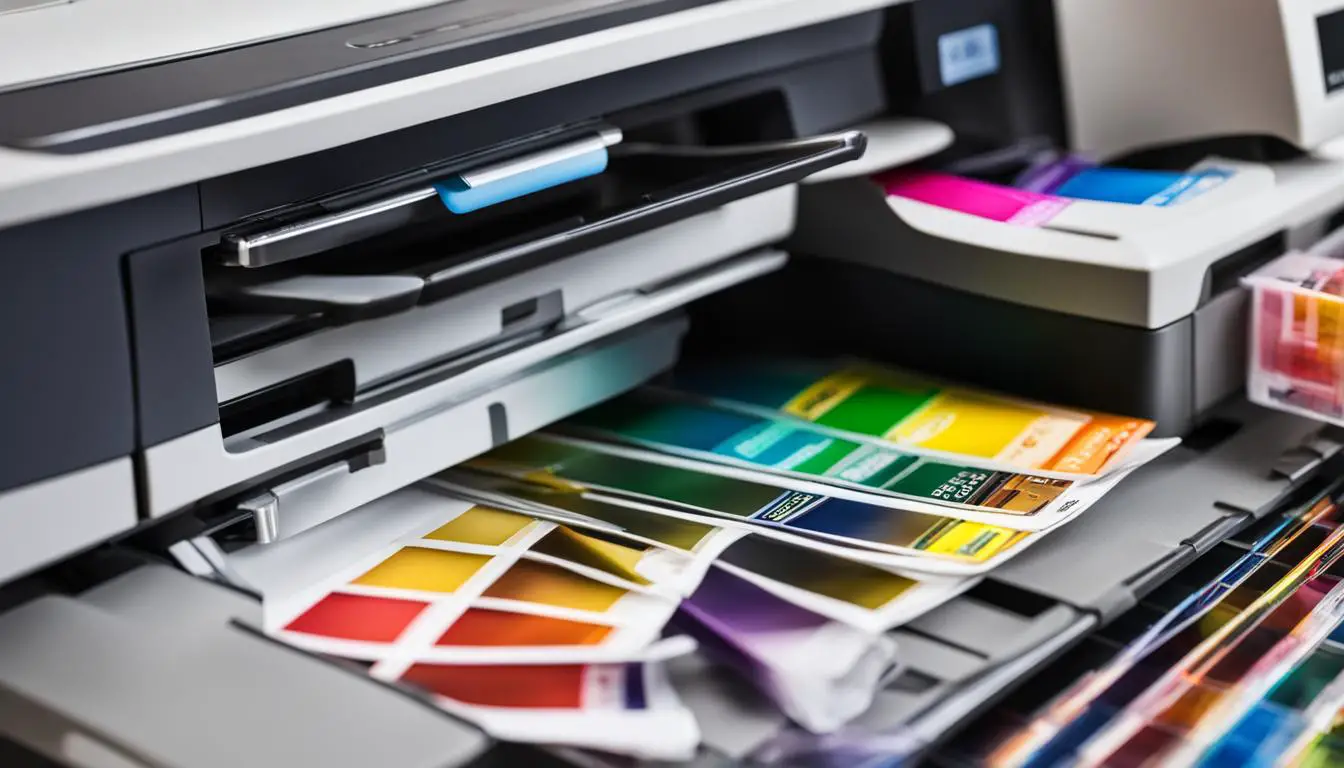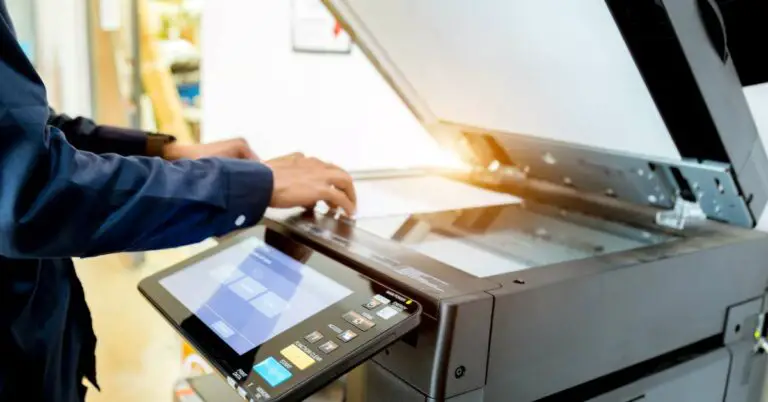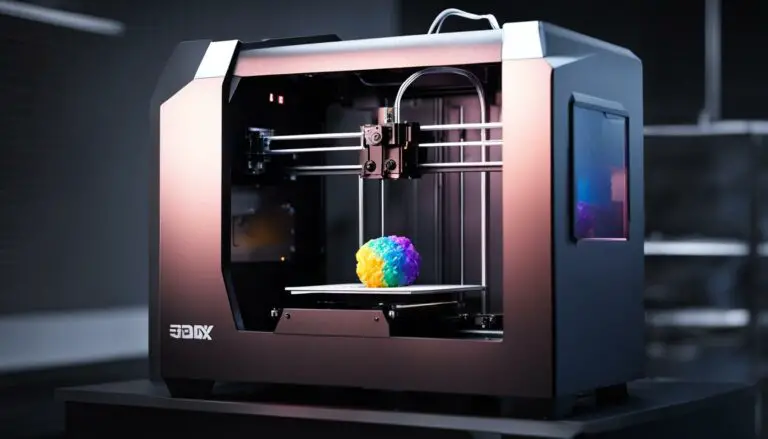Understanding Your Cost Per Page: Printer Efficiency Guide
Originally posted on November 13, 2023 @ 8:43 am
It is essential to calculate the cost per page for your printer in order to effectively manage your printing expenditures. This cost reflects the price of printing a single page with a designated printer cartridge, determined by dividing the cartridge price by its page yield. By accurately determining the cost per page, you can make informed choices when it comes to buying printers and cartridges, resulting in reduced printing expenses.
Key Takeaways:
- Calculating the cost per page helps you understand and manage printing expenses.
- The cost per page is determined by dividing the cartridge price by the page yield.
- Purchasing printers and cartridges based on cost per page can lead to savings.
- Consider factors like cartridge cost and page yield when calculating cost per page.
- Optimizing printing costs can be achieved through various strategies.
The Factors Affecting Cost Per Page
The cost per page is influenced by two main factors: the cost of the printer cartridge and the page yield of the cartridge. When considering the cost of the printer cartridge, it is important to note that different brands and models can vary significantly in price. Some cartridges may be more expensive due to additional features or advanced technology. Therefore, it is crucial to research and compare different cartridges to find the most cost-effective option for your printing needs.
The second factor that affects the cost per page is the page yield of the cartridge. Page yield refers to the number of pages that can be printed with a cartridge based on 5% page coverage. It is important to consider the page yield along with the cost of the cartridge when calculating the cost per page. A cheaper cartridge may have a lower page yield, which could result in higher overall printing costs in the long run.
The Importance of Page Yield
Page yield is a critical factor to consider when calculating the cost per page. It represents the approximate number of pages that can be printed with a cartridge, based on 5% page coverage. It is important to note that the actual page yield may vary depending on the type of documents being printed. Graphics-heavy or high-coverage documents may require more ink or toner, resulting in a lower page yield. Therefore, it is essential to assess your typical printing needs and choose a cartridge with a suitable page yield to optimize your printing costs.
To make informed decisions regarding your printing expenses, it is necessary to consider both the cost of the printer cartridge and the page yield. By understanding the factors that affect the cost per page, you can effectively manage your printing costs and save money in the long run. When purchasing cartridges, it is important to balance the upfront cost with the expected page yield to ensure optimal cost efficiency for your printing needs.
| Factor | Impact |
|---|---|
| Cost of the printer cartridge | Higher cost may lead to higher overall printing expenses |
| Page yield of the cartridge | Lower page yield may result in more frequent cartridge replacement and higher printing costs |
How to Calculate Cost Per Page
Calculating the cost per page is a straightforward process that can help you make informed decisions and manage your printing expenses effectively. To calculate the cost per page, you need to divide the price of the printer cartridge by its page yield. The page yield represents the approximate number of pages that can be printed with a cartridge, based on 5% page coverage.
Cost per page = Cartridge price / Page yield
For example, if a printer cartridge costs $50 and has a page yield of 1000 pages, the cost per page would be $0.05. By calculating the cost per page, you can compare different cartridges and printers to find the most cost-effective options for your printing needs.
| Cartridge Price | Page Yield | Cost per Page |
|---|---|---|
| $50 | 1000 | $0.05 |
| $60 | 1200 | $0.05 |
| $40 | 800 | $0.05 |
By comparing the cost per page of different cartridges, you can choose the most cost-effective option and save on your printing expenses in the long run.
Cost Saving Tips for Lowering Your Cost Per Page
When it comes to reducing printing expenses, there are several cost-saving tips you can implement to lower your cost per page. These tips will not only help you save money but also promote sustainable printing practices. By adopting these strategies, you can optimize your printing costs and make your printing operations more efficient and economical.
Choose a Printer with a Low Cost Per Page
One of the most effective ways to lower your cost per page is to choose a printer that offers affordable printing costs. Research and compare different printer models to find one that has a low cost per page. Look for printers that have high page yields and are known for their efficiency. Investing in a printer with a low cost per page upfront can result in significant savings in the long run.
Use Compatible Alternative Cartridges
Another cost-saving tip is to consider using compatible alternative cartridges from reputable suppliers. These cartridges offer similar page yields to original cartridges but at a lower price point. By opting for compatible cartridges, you can significantly reduce your printing costs without sacrificing print quality. Make sure to choose cartridges that are compatible with your printer model to ensure optimal performance.
Be Mindful of Your Printing Habits
Being mindful of your printing habits can also help lower your cost per page. Only print when necessary and avoid unnecessary printing. Consider using the print preview function to check documents before printing and ensure you are printing only what you need. Additionally, choose double-sided printing whenever possible to reduce paper consumption. Using the draft mode for less important documents can also help save ink or toner. By adopting these habits, you can minimize waste and reduce your printing expenses.
Summary
Lowering your cost per page is essential for managing your printing expenses and optimizing your printing operations. By choosing a printer with a low cost per page, using compatible alternative cartridges, and being mindful of your printing habits, you can significantly reduce your printing costs. These cost-saving tips not only help you save money but also contribute to sustainability by minimizing waste and promoting responsible printing practices. Start implementing these strategies today to lower your cost per page and achieve more affordable printing options.
Understanding Printing Costs for Different Printers
When it comes to printing costs, it’s important to consider the type of printer you are using. Inkjet printers and laser printers have different printing costs, and understanding these differences can help you make informed decisions and save on your printing expenses.
Printing Costs for Inkjet Printers
Inkjet printers are known for their high-quality color printing capabilities. However, they typically have a higher cost per page compared to laser printers. This is because inkjet printers have lower page yields, meaning they can print fewer pages per cartridge. Inkjet cartridges also need to be replaced more frequently, further adding to the overall printing costs. If you frequently print high-resolution images or color documents, an inkjet printer may be the right choice for you. However, it’s important to consider the higher printing costs associated with inkjet printers.
Printing Costs for Laser Printers
Laser printers, on the other hand, offer a more cost-effective solution for high-volume printing. Laser printers have higher page yields and can generally print more pages per cartridge compared to inkjet printers. This means you will need to replace the cartridges less frequently, resulting in lower printing costs over time. Laser printers are ideal for businesses or individuals who regularly print large volumes of documents, especially black and white documents. While laser printers may have a higher upfront cost, the lower cost per page can result in significant savings in the long run.
When comparing printers, it’s important to factor in both the initial cost of the printer and the ongoing printing costs. Consider your printing needs and volume to determine which type of printer offers the most cost-effective solution for you.
| Inkjet Printers | Laser Printers | |
|---|---|---|
| Print Quality | High-quality color printing | Fast and sharp black and white printing |
| Page Yield | Lower page yields | Higher page yields |
| Cartridge Lifespan | Needs frequent replacement | Requires less frequent replacement |
| Printing Volume | Best for low to moderate volume printing | Ideal for high-volume printing |
| Upfront Cost | Lower upfront cost | Higher upfront cost |
| Cost per Page | Higher cost per page | Lower cost per page |
Understanding the different printing costs associated with inkjet and laser printers can help you make an informed decision when choosing a printer that suits your needs and budget. Consider the print quality, page yield, cartridge lifespan, printing volume, upfront cost, and cost per page to determine which type of printer offers the best value for your printing requirements.
The Importance of Proper Print Cost Analysis
Proper print cost analysis is vital for managing your printing expenses and effectively budgeting for printing costs. By understanding the cost per page for your printer, you can accurately estimate your printing expenses and make informed decisions when it comes to purchasing printers and cartridges.
Print cost analysis also helps identify areas for potential cost savings. By choosing cost-effective printers and using compatible alternative cartridges, you can significantly reduce your printing costs. Regularly analyzing and monitoring your print costs allows you to optimize your printing processes, minimize unnecessary expenses, and maximize your budget.
To facilitate print cost analysis, consider using print tracking software. This technology allows you to monitor printing activities, track usage, and allocate costs to specific departments or individuals. By leveraging this data, you can identify areas for cost reduction and implement print policies to minimize wasteful printing. Additionally, automated supply ordering systems can streamline the process of ordering cartridges and other printing supplies, ensuring that you always have the necessary resources while minimizing inventory costs.
Benefits of Proper Print Cost Analysis:
- Accurately estimate printing expenses
- Informed decision-making for printer and cartridge purchases
- Identify areas for potential cost savings
- Optimize printing processes and minimize unnecessary expenses
- Implement print policies to reduce wasteful printing
- Streamline supply ordering and minimize inventory costs
| Cost Savings | Print Cost Analysis Strategies |
|---|---|
| Choosing cost-effective printers | Research and compare different printer models |
| Using compatible alternative cartridges | Purchase cartridges from reputable suppliers |
| Implementing print policies | Print double-sided, use draft mode, and print only when necessary |
| Automating supply ordering | Utilize automated systems for cartridge and supply replenishment |
The Benefits of Managed Print Services
Managed Print Services (MPS) offer a comprehensive solution for optimizing print costs and streamlining print management. By outsourcing print management to an MPS provider, you can benefit from their expertise in assessing your printing needs, analyzing your print environment, and recommending cost-saving measures. This includes evaluating your current printing infrastructure and identifying opportunities for print cost optimization.
One of the key advantages of MPS is the ability to automate supply ordering. MPS providers can implement systems that monitor your printer consumables and automatically order replacements when needed. This ensures that you always have the necessary supplies without the hassle of manual ordering or the risk of running out of ink or toner. Not only does this save you time and resources, but it also eliminates the potential for printing delays and interruptions.
MPS providers also offer print security solutions to help protect your sensitive information. They can implement secure printing processes, such as requiring user authentication at the printer, to ensure that documents are only printed by authorized individuals. This helps prevent unauthorized access to confidential information and reduces the risk of data breaches.
The Impact of Managed Print Services on Cost Reduction
By leveraging the expertise and resources of an MPS provider, businesses can achieve significant cost reductions in their printing operations. According to research, organizations that implement MPS typically experience cost savings of 30% or more. These savings come from various areas, including reduced printing waste, optimized printer fleet management, and improved print efficiency.
An MPS provider can help you implement sustainable printing practices, such as print tracking and print policy enforcement, which can reduce unnecessary printing and lower overall print volumes. By analyzing your printing habits and providing insights into your print environment, an MPS provider can help you identify areas where printing can be minimized or eliminated altogether.
| Cost Savings Areas | Potential Savings |
|---|---|
| Reduced printing waste | Up to 20% |
| Optimized printer fleet management | Up to 30% |
| Improved print efficiency | Up to 40% |
“Managed Print Services can provide significant cost savings by reducing printing waste, optimizing printer fleet management, and improving print efficiency.”
Furthermore, an MPS provider can help you consolidate your printer fleet, removing redundant or underutilized devices. By streamlining your printing infrastructure, you can reduce maintenance costs, lower energy consumption, and minimize the need for multiple types of supplies and consumables.
In summary, managed print services offer a range of benefits for cost optimization and efficient print management. By outsourcing your print needs to an MPS provider, you can benefit from their expertise, reduce costs, improve print efficiency, and enhance print security. Consider partnering with an MPS provider to unlock the full potential of managed print services and optimize your printing operations.
The Role of Technology in Print Cost Reduction
Technology plays a significant role in reducing print costs and optimizing your overall printing expenses. By leveraging the right tools and software, you can effectively manage and track your print activities, automate supply ordering, and implement cost-saving measures.
Print Tracking Software
One key technology for cost reduction is print tracking software. This software allows you to monitor and analyze your printing activities, track usage patterns, and allocate costs to specific departments or individuals. By gaining insights into your print behavior, you can identify areas for improvement and implement print policies to minimize unnecessary printing. With print tracking software, you can take a data-driven approach to reduce waste, optimize resources, and ultimately lower your print costs.
Automated Supply Ordering
Another technology that can significantly reduce print costs is automated supply ordering systems. These systems streamline the process of ordering cartridges and other printing supplies, ensuring that you always have the necessary resources on hand while minimizing inventory costs. By automating the supply ordering process, you can eliminate the risk of running out of cartridges and prevent unnecessary rush orders. This not only saves you time but also helps you maintain a cost-effective printing operation.
“By leveraging technology, such as print tracking software and automated supply ordering systems, businesses can optimize their print costs and improve efficiency.”
Other Technological Advancements
Besides print tracking software and automated supply ordering, there are other technological advancements that can contribute to print cost reduction. For example, innovative printing devices now offer features like duplex printing (printing on both sides of the paper) and eco-mode (reducing ink or toner usage), which can further minimize printing expenses. Additionally, advancements in digital document management solutions enable businesses to transition to paperless workflows, saving on paper, ink, and storage costs.
By embracing these technologies and incorporating them into your print management strategy, you can effectively reduce print costs, optimize your printing operations, and achieve greater cost efficiency.
| Technology | Benefits |
|---|---|
| Print tracking software | – Monitor and analyze print activities |
| Automated supply ordering systems | – Streamline supply procurement process |
| Duplex printing and eco-mode | – Minimize paper and ink/toner consumption |
| Digital document management solutions | – Transition to paperless workflows |
The Importance of Employee Training and Awareness
Employee training and awareness play a crucial role in reducing unnecessary printing and promoting responsible printing practices in the workplace. By educating your employees about the cost per page and the impact of their printing habits, you can encourage more conscious and sustainable printing behaviors. This can lead to significant cost savings and contribute to a greener environment.
One effective approach is to train employees on how to print responsibly. Encourage them to print double-sided whenever possible and utilize print preview to avoid unnecessary prints. By emphasizing digital alternatives such as sharing files electronically or storing documents in the cloud, you can significantly reduce the amount of paper and ink consumed.
“Responsible printing practices not only save costs but also contribute to environmental sustainability. By raising awareness among employees about the impact of their printing habits, businesses can achieve significant reductions in printing expenses while minimizing their carbon footprint.”
Benefits of Employee Training and Awareness:
- Cost savings through reduced ink/toner consumption and paper usage
- Increased environmental sustainability and reduced carbon footprint
- Promotion of a culture of responsible printing and resource conservation
- Improved awareness of print-related costs, leading to more conscious printing decisions
By investing in employee training and awareness programs, businesses can foster a print-conscious culture and achieve substantial cost savings. This, in turn, contributes to a more sustainable and environmentally friendly workplace.
| Benefits of Employee Training and Awareness | Impact |
|---|---|
| Cost savings through reduced ink/toner consumption and paper usage | Significant reduction in printing expenses |
| Increased environmental sustainability and reduced carbon footprint | Contribution to a greener workplace |
| Promotion of a culture of responsible printing and resource conservation | Improved environmental practices |
| Improved awareness of print-related costs, leading to more conscious printing decisions | Optimized printing processes and reduced wasteful printing |
The Future of Printing: Environmental Impact and Sustainability
As printing technology continues to advance, it is crucial to consider the environmental impact and the need for sustainable printing practices. The printing industry has been historically associated with significant resource consumption and waste generation. However, manufacturers and businesses are now actively working towards developing and implementing eco-friendly solutions to minimize the environmental footprint of printing.
One of the key areas of focus is the development of sustainable printing practices. This involves adopting green printing solutions that prioritize the efficient use of resources and reduce waste. For example, many manufacturers are designing printers and cartridges that are made from recycled materials and can be easily recycled at the end of their lifespan. These eco-friendly products not only reduce the environmental impact of printing but also promote a circular economy.
In addition to sustainable product design, businesses can also embrace practices that minimize paper usage. Paperless initiatives, such as digital document management systems and electronic communication platforms, can significantly reduce the need for printing. By encouraging employees to use digital alternatives whenever possible, businesses can save on paper costs and reduce their overall environmental footprint.
“Sustainable printing practices not only reduce the environmental impact but also promote a circular economy.”
Furthermore, responsible recycling of printer cartridges is another crucial aspect of sustainable printing. Many manufacturers and retailers now offer recycling programs for used cartridges, allowing them to be properly disposed of and potentially reused or remanufactured. By participating in these recycling initiatives, businesses can contribute to reducing electronic waste and promoting a more sustainable printing industry.
| Sustainable Printing Practices | Benefits |
|---|---|
| Use of recycled materials for printers and cartridges | Reduces resource consumption and waste generation |
| Paperless initiatives | Minimizes paper usage and saves on costs |
| Responsible recycling of printer cartridges | Reduces electronic waste and promotes sustainability |
In conclusion, the future of printing lies in adopting sustainable practices that prioritize environmental impact and resource efficiency. Through the use of eco-friendly products, paperless initiatives, and responsible recycling, businesses can contribute to a greener and more sustainable printing industry. Embracing these practices not only benefits the environment but also helps businesses save on costs and demonstrate their commitment to corporate social responsibility.
Conclusion
In conclusion, understanding and optimizing your cost per page is crucial for managing your printing expenses and reducing overall printing costs. By calculating the cost per page, considering factors such as cartridge cost and page yield, and implementing cost-saving strategies, you can make informed decisions when it comes to purchasing printers and cartridges.
Utilizing technology, such as print tracking software and automated supply ordering systems, can further streamline and optimize your print costs. Additionally, employee training and awareness play a vital role in promoting responsible printing practices and reducing unnecessary printing.
Looking ahead, the future of printing lies in environmental impact and sustainability. Adopting eco-friendly printers, implementing paperless initiatives, and responsibly recycling printer cartridges are just some of the ways businesses can contribute to a greener and more sustainable future.
Whether you take individual cost-saving actions or seek the assistance of managed print services, optimizing your printing costs will lead to significant savings in the long run. Start analyzing your printing costs today and discover the potential for cost reduction and efficiency improvement.
FAQ
What is the cost per page for a printer?
The cost per page refers to the amount it costs to print a single page using a specific printer cartridge. It is calculated by dividing the cartridge price by the page yield.
What does page yield mean?
Page yield represents the approximate number of pages that can be printed with a cartridge. It is based on 5% page coverage and may vary depending on the type of document being printed.
How do I calculate the cost per page?
To calculate the cost per page, divide the cartridge price by the page yield. The formula is: Cartridge Price / Page Yield = Cost Per Page
How can I lower my cost per page?
You can lower your cost per page by choosing a printer with a low cost per page, using compatible alternative cartridges, being mindful of your printing habits, and utilizing cost-saving features like double-sided printing and draft mode.
Do different types of printers have different cost per page?
Yes, inkjet printers generally have a higher cost per page compared to laser printers. This is because inkjet printers have lower page yields and require more frequent cartridge replacement.
Why is proper print cost analysis important?
Proper print cost analysis allows you to effectively manage and budget for printing expenses. It helps identify areas for potential cost savings and ensures efficient printing operations.
What are the benefits of managed print services?
Managed print services offer a comprehensive solution for optimizing print costs. They provide print assessment, cost-saving recommendations, automated supply ordering, maintenance monitoring, and improved print security.
How can technology help reduce print costs?
Technology such as print tracking software and automated supply ordering systems can help monitor printing activities, allocate costs, streamline processes, and minimize wasteful printing.
How can employee training and awareness contribute to cost reduction?
Training employees on the cost per page and promoting responsible printing practices can help reduce unnecessary printing. This includes using double-sided printing, print preview, and digital alternatives when possible.
What is the future of printing in terms of environmental impact and sustainability?
There is a growing focus on sustainable printing practices, such as eco-friendly printers, paperless initiatives, digital document management, and responsible recycling of cartridges, to reduce the environmental impact of printing.








